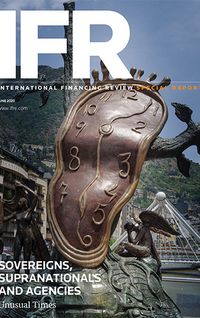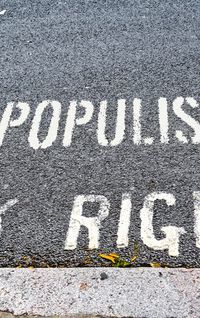Anything that was in the in tray for the Federal Reserve and the US Treasury for 2020 has been rudely displaced by coronavirus. The ultimate costs and consequences remain undetermined but the role of the state is clearly larger and more inextricably entwined with the economy than before.
In his book about the July 1914 crisis, American historian Michael Neiberg says that the declaration of war hit the great majority of Europeans “like a thunderbolt out of a clear blue sky”. Similarly, the Covid-19 pandemic of 2020 was entirely unexpected, and though its ramifications might not be as far-reaching or as traumatic as the 1914-1918 world war, global economies will be living with its effect for a long time to come.
The US federal budget deficit was just a little shy of US$1trn before the vast array of stimulus packages unleashed to shore up a battered economy; it is now likely to be in the region of US$4trn for the current financial year.
“We forecast deficits of US$4trn in financial year 2020 and another US$2.3trn in 2021, reflecting the stimulus that has already passed, expectations of an additional US$500bn in fiscal support and a reduced growth strategy,” said Phoebe White, US government bond strategist at JP Morgan.
Moreover, the risks to this figure are to the upside, as the administration is thought likely to have to introduce further stimulus measures later in the year. This is particularly true if no vaccine for Covid-19 is found in the near term and the economy remains fragile and acutely sensitive to alarums.
This means that the US Treasury will have to borrow a lot more than it anticipated in 2020 and next year, and a lot more than has ever been borrowed before. On May 6 2020, it announced that it will borrow US$3trn in the second quarter, which is more than three times greater than its previous largest quarterly borrowing set during the financial crisis year of 2008.
How much debt-raising will have been completed by the end of the calendar year is a subject of some debate, but JP Morgan, for example, forecasts US$4.686trn of marketable borrowing. Bank of America is slightly more conservative and predicts US$4.2trn this calendar year and another US$2trn next year, while Deutsche Bank forecasts for US$4.5trn for the fiscal year.
If anything, these estimates might err on the conservative side.
“It’s pretty clear Congress is not worrying about spending right now. What they want to do is get the economy back to the original starting point. The top priority is the labour market, and there is empirical evidence which says the longer the workforce is out of work the more depressed aggregate demand becomes,” said Steven Zeng, US rates strategist at Deutsche Bank.
It would usually be axiomatic that such an increase in debt issuance leads to wider yields, but in fact very few observers expect rates, especially in the short and medium maturities, to be much different at the end of the year. At the close on Friday May 29, three-month bills were 0.13%, the five-year note was 0.30%, the 10-year note was 0.65% and the 30-year bond was 1.41%.
There are several reasons why Treasury yields are expected to remain broadly unchanged. First, Treasuries will be the recipient of safe-haven buying during a fraught year in the world’s history. How much the US economy will contract is a moot point, but some of the numbers being bandied about are eye-watering.
Deutsche Bank has predicted US GDP will shrink by 40% in the second quarter, while Credit Suisse has gone an only slightly more reassuring 33.5% contraction in the same period.
In 2008, US GDP contracted at an annual rate of 8.5%, but it is entirely possible this will be exceeded in 2020. Indeed, the 13% decline seen in 1932, in the teeth of the Great Depression, is within Covid-19’s sights.
Inflows to Treasuries are also likely thanks to a far-from-stable geopolitical climate, with fractured Sino-US relations, rioting throughout the US and an election year topping the bill of worries.
“We’ve been recommending clients curb their enthusiasm for higher rates as we think reopening the economy will be very delicate, and more waves of virus outbreaks will keep consumers cautious,” said Mark Cabana, head of US rates strategy at Bank of America.
But the gargantuan and undimmed appetite for Treasuries from the Federal Reserve is the principal reason why Treasury rates should be mostly range bound for the remainder of the year. The Fed’s balance sheet has leapt from around US$4trn at the beginning of March to US$7trn at the end of May. It is currently buying around US$7bn-$8bn a day and should settle into a steady pattern of around US$100bn a month, say Fed watchers. Its balance sheet is expected to be in the region of US$10trn by the end of 2020.
Its initial intervention in the market was to ease liquidity at a time when a lot of markets had frozen, but it has kept going to aid the stimulus and keep rates low.
“So far, the rate of increase in the Fed balance sheet has exceeded the rate of Treasury issuance, so the net amount of Treasuries available to the private sector is actually lower than it was pre Covid-19,” said Ebrahim Rahbari, global head of foreign exchange analysis at Citigroup.
In these conditions, rates should remain rangebound. The 10-year, for example, is not generally expected to yield more than 1% by the end of year, and could well yield less.
There is, however, a little more dissension about the upward limit of long-end rates and whether the curve will steepen further. This area of the curve is less affected by the factors which offset higher yields seen at the shorter maturities and tends to be more volatile.
The Treasury’s borrowing plans, which were divulged on May 6, came as a surprise to the market. The 2s/30s backed up from 113bp on the close on May 5 to 124bp 24 hours later, with the 30-year bellwether selling off from 1.32% to 1.41%.
Not only did the Treasury announce the reintroduction of the 20-year bond, which has not been a regular feature of the market since 1986, but it intends to shift a greater percentage of borrowing than expected to the long end. Ten-year borrowing in the second quarter was increased by US$5bn and 30-year borrowing by US$3bn, when the market had anticipated around US$1bn-$2bn at each maturity. It seems likely the Treasury decided to focus a bigger percentage of its borrowing at the longer end to lock in historically low rates.
OVERSEAS CONSIDERATIONS
There is also a question mark over the extent of overseas participation in the long end of the market. Foreign buyers tend to have a considerably smaller portion of their portfolios devoted to long-end assets. Moreover, it has been suggested that the recent souring of relations between Washington and Beijing will lead to retaliatory actions by China. While it might not become an aggressive seller of Treasuries, the People's Bank of China may curb new purchases and simply let existing maturities run off. At the end of March, the Bank of China held US$1.08trn in Treasury bills, notes and bonds.
All this will put increasing pressure on the Federal Reserve to intervene to keep long-end rates lower, and, consequently, some economists call for renewed steepening. But not everyone is convinced. “Many investors are in the steepener camp but I’m sceptical. I think we remain rangebound for the time being,” said Rahbari.
The Fed is equal to the task in hand; it has a very large bazooka. And it will be watching the 30-year yield closely, as a great many consumer and loan products are tied to it. Nor is it by any means clear that the PBOC will decide exact vengeance by absenting itself from Treasury auctions. The principal aim of its policy for a long time has been to prevent appreciation of its currency, and this is unlikely to change in the midst of a dramatic global slowdown. It needs to put the dollars it buys to depress the yuan to work somewhere.
“What are the alternatives? There’s no big rush to turn dollars into euros,” said Rahbari.
Overseas pension funds and insurance companies will remain a relatively robust source of long end demand as well, especially those based in Japan which buy long end dollar-denominated assets on a hedged basis. Another strategist pointed out that domestic investment funds should also soak up some Treasuries as they are a burgeoning component of the Bloomberg Barclays US Aggregate Bond Index.
A hot topic among dealers and strategists in New York during May was the likelihood of negative rates. On May 8, the one-year Fed fund futures market closed below 0%.
However, the Fed chair Jerome Powell has made it clear, on a number of different occasions, that he regards negative rates as a bad thing.
“The committee’s view on negative rates really has not changed. This is not something we’re looking at,” he said on May 13, five days after the Fed funds rate dipped into negative territory. He noted that in October all 17 Fed policymakers agreed this was not an avenue down which the Fed should go and that such unanimity of opinion is far from usual.
If the Fed wishes to prevent negative rates, it could, for example, raise the interest on earned reserves rate, which was introduced during the financial crisis. It acts as a magnet for a variety of short-term rates - the repo market pegs its levels against the IOER for example.
“If the Fed raises the IOER by 5bp or 10bp, it sends a very clear message it wants rates to go higher,” said Deutsche Bank's Zeng.
It is doubtless one of the less obvious ironies of the Covid-19 pandemic that a US administration which entered office determined to trim the profile of the state has ended up by taking an increasingly large slice of the US economy under its wing. Far from leaving the markets to look after themselves while needless regulation was pared back, the presidency of Donald Trump has played host to state intervention on a titanic scale.
GSEs elude the crosshairs again
Mark Calabria was appointed director of the Federal Housing Authority in April 2019 and made no secret of his desire to take the government-sponsored enterprises Fannie Mae and Freddie Mac out of conservatorship. It is a theme to which he has returned frequently in the last year, lest there should be any doubt about it.
Calabria is clearly worried about the potential burden upon the US taxpayer, who saved the GSEs during the financial crisis. He has added that he regards the decision not to wipe out the shareholders in Fannie and Freddie in 2008 as a great mistake, and also said he will not hesitate to do so next time around if the circumstances present themselves.
Although capital has been built up lately, their leverage levels are out of step with financial institutions. Calabria spelled out the danger in a speech to the National Association of Homeowners in Las Vegas in January.
“[Their leverage] still stands at around 300 to one. By contrast, the largest financial institutions in the nation have an average leverage ratio of roughly 10 to one. Given their risks and financial position, even in a modest downturn, Fannie and Freddie will fail,” he said.
But, in the middle of what is a shockingly immodest downturn, the position of the GSEs as quasi-government bodies appears perhaps more secure rather than less. On May 21, the Federal Housing Finance Authority announced that it is proposing new capital rules preparatory to the GSEs leaving conservatorship.
The rules require the GSEs to hold bank-like capital of no less than US$234bn - some 77% more than the original 2018 proposal. It will take years for the GSEs to build up reserves of this order.
At the end of May, it was reported that 4.76 million American homeowners are in forbearance plans, and of these nearly two million are GSE mortgages. This means some 7.2% of all GSE home loans are now in forbearance.
For the next four months, the mortgage servicers must carry the can for the interest and principal payments due on government-guaranteed mortgage-backed securities linked to these loans, but the GSEs exposed to the losses must reimburse the mortgage servicers for the outlay at some stage, as yet undetermined.
The credit risk transfer schemes operated by Fannie and Freddie in the capital markets and insurance market give them some protection if loans currently in forbearance become delinquent. But if delinquencies rise dramatically and burn through these buffers, then the GSEs will have to underwrite losses in government-backed mortgage securities.
Fannie Mae also reported at the beginning of May that profit plunged to US$461m in the first quarter, down from US$4.4bn in the final quarter of 2019.
None of these developments make the GSEs more attractive to potential shareholders. It is likely to be the middle of the next decade before the US government can divest itself of the Tweedle Dum and Tweedle Dee of the housing market.
Simon Boughey
To see the digital version of this report, please click here
To purchase printed copies or a PDF of this report, please email gloria.balbastro@refinitiv.com
![]()




























